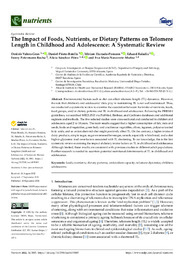Por favor, use este identificador para citar o enlazar este ítem:
https://hdl.handle.net/11000/34901Registro completo de metadatos
| Campo DC | Valor | Lengua/Idioma |
|---|---|---|
| dc.contributor.author | Valera-Gran, Desireé | - |
| dc.contributor.author | Prieto Botella, Daniel | - |
| dc.contributor.author | Hurtado-Pomares, Miriam | - |
| dc.contributor.author | Baladia, Eduard | - |
| dc.contributor.author | Petermann-Rocha, Fanny | - |
| dc.contributor.author | Sánchez-Pérez, Alicia | - |
| dc.contributor.author | Navarrete-Muñoz, Eva María | - |
| dc.contributor.other | Departamentos de la UMH::Patología y Cirugía | es_ES |
| dc.date.accessioned | 2025-01-18T09:25:20Z | - |
| dc.date.available | 2025-01-18T09:25:20Z | - |
| dc.date.created | 2022-09-20 | - |
| dc.identifier.citation | Nutrients . 2022 Sep 20;14(19):3885 | es_ES |
| dc.identifier.issn | 2072-6643 | - |
| dc.identifier.uri | https://hdl.handle.net/11000/34901 | - |
| dc.description.abstract | Environmental factors such as diet can affect telomere length (TL) dynamics. However, the role that children's and adolescents' diets play in maintaining TL is not well understood. Thus, we conducted a systematic review to examine the association between the intake of nutrients, foods, food groups, and/or dietary patterns and TL in childhood and adolescence. Following the PRISMA guidelines, we searched MEDLINE via PubMed, Embase, and Cochrane databases and additional registers and methods. The five selected studies were cross-sectional and conducted in children and adolescents aged 2 to 18 years. The main results suggest that a higher consumption of fish, nuts and seeds, fruits and vegetables, green leafy and cruciferous vegetables, olives, legumes, polyunsaturated fatty acids, and an antioxidant-rich diet might positively affect TL. On the contrary, a higher intake of dairy products, simple sugar, sugar-sweetened beverages, cereals, especially white bread, and a diet high in glycaemic load were factors associated with TL shortening. To our knowledge, this is the first systematic review examining the impact of dietary intake factors on TL in childhood and adolescence. Although limited, these results are consistent with previous studies in different adult populations. Further research is needed to ascertain potential nutritional determinants of TL in childhood and adolescence. | es_ES |
| dc.format | application/pdf | es_ES |
| dc.format.extent | 14 | es_ES |
| dc.language.iso | eng | es_ES |
| dc.publisher | Board | es_ES |
| dc.rights | info:eu-repo/semantics/openAccess | es_ES |
| dc.rights | Attribution-NonCommercial-NoDerivatives 4.0 Internacional | * |
| dc.rights.uri | http://creativecommons.org/licenses/by-nc-nd/4.0/ | * |
| dc.subject | adolescents | es_ES |
| dc.subject | antioxidant capacity | es_ES |
| dc.subject | children | es_ES |
| dc.subject | dietary patterns | es_ES |
| dc.subject | foods | es_ES |
| dc.subject | nutrients | es_ES |
| dc.subject | telomere dynamics | es_ES |
| dc.title | The Impact of Foods, Nutrients, or Dietary Patterns on Telomere Length in Childhood and Adolescence: A Systematic Review | es_ES |
| dc.type | info:eu-repo/semantics/article | es_ES |
| dc.relation.publisherversion | 10.3390/nu14193885 | es_ES |

Ver/Abrir:
The Impact of Foods, Nutrients, or Dietary Patterns on Telomere Length in Childhood and Adolescence.pdf
753,68 kB
Adobe PDF
Compartir:
 La licencia se describe como: Atribución-NonComercial-NoDerivada 4.0 Internacional.
La licencia se describe como: Atribución-NonComercial-NoDerivada 4.0 Internacional.
.png)